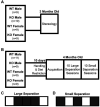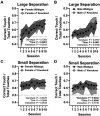Genetic deletion of α7 nAChRs reduces hippocampal granule and pyramidal cell number in both sexes but impairs pattern separation in males only
- PMID: 37746145
- PMCID: PMC10513752
- DOI: 10.3389/fnins.2023.1244118
Genetic deletion of α7 nAChRs reduces hippocampal granule and pyramidal cell number in both sexes but impairs pattern separation in males only
Abstract
Introduction: Neurogenesis within the dentate gyrus is thought to play an important role in cognitive processes such as reversal learning and pattern separation. The α7 nicotinic acetylcholine receptor (α7 nAChR) is expressed early in newly formed granule cells of the dentate gyrus, though its role in neurogenesis and related cognitive function is not fully understood.
Methods: To better characterize relevant function of α7 nAChRs, we performed unbiased stereology to quantify hippocampal granule cells, pyramidal cells, and total volume and used a touchscreen operant spatial discrimination/reversal task to test pattern separation in a global α7 nAChR knockout mouse line.
Results: The knockout resulted in an ≈22% reduction in granule cells and a ≈ 20% reduction in pyramidal cells in both sexes, with no change in total hippocampal volume. However, the knockout impaired performance in the touchscreen task for males only. The sex-dependent difference in behavioral, but not stereological, results suggest a divergence in the structure-function relationship in males versus females. Detailed analyses revealed males were more biased by the initial reversal contingency relative to females indicating a potential source of the sex-specific interaction with the loss of α7 nAChRs.
Discussion: These findings argue that the α7 nAChR plays a critical role in hippocampal development, not just granule cell neurogenesis, and plays a sex-dependent role in cognitive function.
Keywords: CHRNA7; acetylcholine; cognitive flexibility; stereology; touchscreen.
Copyright © 2023 Letsinger, Nacer, Stevanovic, Larson, DeFilipp, Cushman and Yakel.
Conflict of interest statement
GL was employed by Social & Scientific Systems, Inc., a DLH Holdings Corp. Company, and received funding from contract GS-00F-173CA-75N96021F00109 to assist in analyzing behavioral data. The remaining authors declare that the research was conducted in the absence of any commercial or financial relationships that could be construed as a potential conflict of interest.
Figures






Similar articles
-
The α7 nicotinic acetylcholine receptors regulate hippocampal adult-neurogenesis in a sexually dimorphic fashion.Brain Struct Funct. 2019 Mar;224(2):829-846. doi: 10.1007/s00429-018-1799-6. Epub 2018 Dec 4. Brain Struct Funct. 2019. PMID: 30515567 Free PMC article.
-
Loss of α7 nicotinic acetylcholine receptors in GABAergic neurons causes sex-dependent decreases in radial glia-like cell quantity and impairments in cognitive and social behavior.Brain Struct Funct. 2021 Mar;226(2):365-379. doi: 10.1007/s00429-020-02179-3. Epub 2021 Jan 4. Brain Struct Funct. 2021. PMID: 33398432 Free PMC article.
-
Bidirectional Regulation of Aggression in Mice by Hippocampal Alpha-7 Nicotinic Acetylcholine Receptors.Neuropsychopharmacology. 2018 May;43(6):1267-1275. doi: 10.1038/npp.2017.276. Epub 2017 Nov 7. Neuropsychopharmacology. 2018. PMID: 29114104 Free PMC article.
-
Modulation of hippocampal neuronal network oscillations by α7 nACh receptors.Biochem Pharmacol. 2015 Oct 15;97(4):445-453. doi: 10.1016/j.bcp.2015.06.031. Epub 2015 Jul 21. Biochem Pharmacol. 2015. PMID: 26206189 Review.
-
[Dual Roles of α7 Nicotinic Acetylcholine Receptors Expressed in Immune Cells in T Cell Differentiation -α7 nAChRs Exert Different Actions between Antigen-presenting Cells and CD4+ T Cells].Yakugaku Zasshi. 2020;140(12):1421-1425. doi: 10.1248/yakushi.20-00151. Yakugaku Zasshi. 2020. PMID: 33268683 Review. Japanese.
References
-
- Bates R. C., Stith B. J., Stevens K. E., Adams C. E. (2014). Reduced Chrna7 expression in C3H mice is associated with increases in hippocampal parvalbumin and glutamate decarboxylase-67 (GAD67) as well as altered levels of GABAA receptor subunits. Neuroscience 273, 52–64. doi: 10.1016/j.neuroscience.2014.05.004, PMID: - DOI - PMC - PubMed
LinkOut - more resources
Full Text Sources
Molecular Biology Databases

